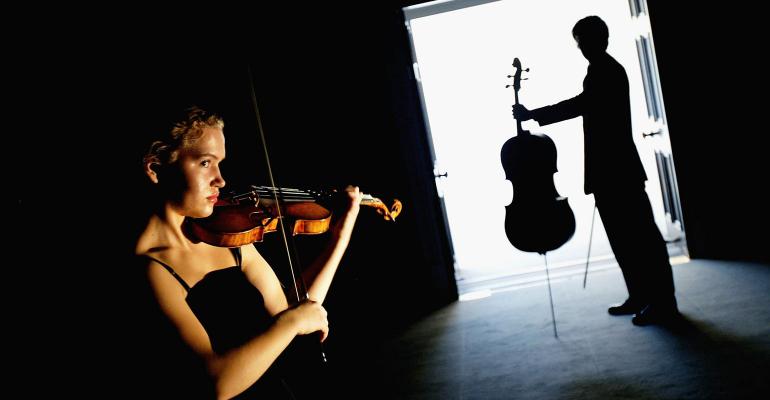In today’s economy, where investments in stocks, bonds, commodities, real estate and hedge funds have either been severely battered or are at record highs and possibly poised for declines, investors are increasingly seeking non-correlated alternative investments.
Auction records for “Elvis’ guitar” or “Liberace’s piano” make headlines, and so do stories captioned “Stradivarius Violin Makes New World Auction Record.” But we often relegate the subject of the headline to our concept of esoterica or say “who would pay so much for that?” However, anything unique and one-of-a-kind collectible objets d’arts now attract greater attention. And experts in the field of rare 17th and 18th Century Italian stringed instruments are advocating Stradivarius and Guarnerius violins and cellos as worthy of focus for investors seeking steady long-term capital appreciation.
One completely unique thing about rare violins is that they are also musicians’ tools of trade — much in demand for their tonal qualities. In the competitive world of top fiddle players, their livelihoods often depend on being known to play an old, master-crafted instrument. As Western classical music gathers momentum in Korea and China, the market for top instruments is expanding there as well.
Skilled European violinmakers were building fine instruments in Italy as far back as 1540. However, the zenith of the art of “lutherie” (violinmaking) was reached approximately 175-200 years later in Cremona, Italy, in the workshops of Stradivarius and his younger colleague, Giuseppe Guarnerius “del Gesu,” whose instruments are equally admired for their tonal qualities. Fine instruments have been created elsewhere, but in terms of mastery of aesthetics and creating miracles of acoustical projection and beauty, the heart of lutherie has always belonged to 18th century Cremona.
Stradivarius and del Gesu instruments command high collectible prices, ranging from $2 million for an unexceptional violin to $20 million. History shows that these instruments have continuously increased in value from Strad’s lifetime, when only nobility had the resources to order his instruments, until today, when top instruments are generally sold privately. Such sales usually occur outside of auction houses because the ownership and location of each instrument is the focus of a tight-knit circle of highly-active dealers, collectors, foundations and top soloists who rely on them to make their careers. Players sometimes wait for decades to acquire a specific instrument. Even when an instrument of fair quality, i.e., without an undue amount of restoration and where much of the original varnish is still present, hits the auction room, publicity reaches feverish pitch and bidders emerge from across the globe.
Today, the market for the greatest instruments is the subject of keen interest by seekers of alternative investments. Over the past 20 years, many instruments in the top category have climbed in value 12-15 percent per annum, with virtually no downside volatility. Data for individual instruments is available to subscribers at www.cozio.com, detailing rare instrument sales going back almost to their date of creation — including Cremonese makers Antonio Stradivarius, Giuseppe Guarnerius del Gesu, Carlo Bergonzi, J.B. Guadagnini, Venetians Domenico Montagnana and Matteo Goffriller (primarily makers of top cellos). The data reveals one of the few investments where verifiable price information is available over a 200 year period.
Sales of instruments in the six, seven and 10 million dollar range have become common, and some of these instruments were purchased in the 1960s and 1970s for less than $200,000. Generally, the “star factor” of an instrument having been played by a top musician adds allure and fancy prices are paid for instruments once owned by famed violinists Yehudi Menuhin, Ruggiero Ricci and Isaac Stern or the late great cellist Mstislav Rostropovich. The recent economic downturn does not seem to have any impact on the rise in prices, and reports indicate prices are continuing upwards.
Today, dealers and auction rooms all over the world participate in the market. Funds created by corporations, governments and individuals acquire instruments for many reasons: the preservation of art, to provide instruments to younger artists who cannot afford them, for investment returns, or for a combination of all of these objectives. If you are considering investing, there are two possibilities:
1. Buy an individual instrument through a dealer or auction house. The advantage with this approach is that you don’t share in the cachet of the investment with anyone else. The disadvantage is that you have to be absolutely sure of provenance because challenges to authenticity can create a major difference between the purchase price and the instrument’s real value. Additionally, it is critical to make sure the instrument is properly maintained, insured and preferably, played by careful players (most experts agree that antique instruments maintain their integrity best if played regularly). Eventually, when you want to recoup your investment, you’ll have to sell the instrument often with a significant dealer commission payable, ranging from five percent to 20 percent of the sales price; or
2. Add a quasi-charitable component to your purchase and find a middle-aged artist with a valuable instrument. Oftentimes these instruments constitute a significant portion of their net worth. You could offer to purchase half the instrument at a slight discount, creating liquidity for the artist, but allow them to continue to use it until they retire. At that time, you could acquire the rest of the instrument or sell it.
A May 2008 Barrons article captures the essence of these investments. The article also points out that some of these non-traditional assets cannot be sold overnight. And, when coupled with high transaction costs stemming from authentication, restoration, preservation, insurance and broker commissions, investing in a rare stringed instrument should not be an impulsive act.
So, if you're looking to diversify your portfolio with an investment that exhibits low correlation to the rest of the markets and offers the prospect of competitive returns over the long haul, investing in a rare violin fund could be a smart option.
Edward Papier, CIMA, CFP, is the CEO of Amadeus Wealth Advisors which specializes in alternative investments.





